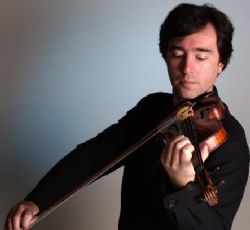|
Symphony
SRS SEASON ENDS WITH RESOUNDING TA-TA-TA-BANG
by Terry McNeill
Sunday, June 1, 2025
Symphony
YOUTHFUL VIRTUOSITY ON DISPLAY AT USO'S MAY CONCERTS
by Peter Lert
Saturday, May 17, 2025
Symphony
MYSTICAL PLANETS AND LIVELY GERSHWIN ORTIZ AT FINAL SRS CONCERT
by Peter Lert
Sunday, May 4, 2025
Symphony
VSO'S CONCERT MUSIC OF TIME, MUSIC OF PLACE
by Peter Lert
Sunday, April 27, 2025
Choral and Vocal
VOCAL ELEGANCE AND FIRE AT THE 222'S RECITAL APRIL 26
by Pamela Hicks Gailey
Saturday, April 26, 2025
CANTIAMO SONOMA SINGS AN INSPIRED GOOD FRIDAY MOZART REQUIEM CONCERT
by Pamela Hicks Gailey
Friday, April 18, 2025
DRAMATIC SHOSTAKOVICH SYMPHONY CLOSES PHILHARMONIC'S 25TH SEASON
by Terry McNeill
Sunday, April 13, 2025
LARGE COLLEGE OF MARIN AUDIENCE GREETS STOPHER ARTISTRY
by Terry McNeill
Saturday, April 5, 2025
Chamber
FRISSON DELIVERS SHIVERS OF DELIGHT
by Abby Wasserman
Sunday, March 30, 2025
OLD AND MOSTLY NEW IN SRS MARCH CONCERT IN WEILL
by Peter Lert
Saturday, March 22, 2025
|
 |
 Violinist Dmitri Berlinsky |
OVERTURE WITHOUT OPERA
by Steve Osborn
Saturday, October 9, 2010
For the opening set of the Santa Rosa Symphony’s 2010-11 season, Music Director Bruno Ferrandis chose four Italian works, perhaps in acknowledgement of that culture’s immense influence on musical history.
The concert began promisingly with a fine rendition of Verdi’s overture to the opera “La Forza del Destino.” The Symphony, augmented by about a dozen players from the Youth Orchestra, played with conviction and solidity. Ferrandis sustained the rhythmic drive throughout, and the brass offered strong statements of the opera’s themes, punctuated by emotional outbursts from the strings. Melody was everywhere.
Sadly, those melodies were soon replaced by the insipid tunes of Paganini’s first violin concerto, a bravura showpiece that includes just about every trick a virtuoso can muster other than musical interest. The piece is all about technique, with little regard for what the notes are actually conveying. Soloist Dmitri Berlinksy proved himself mostly up to the task, traversing the fingerboard with lightning speed and bouncing his bow with alacrity. There were glissandos aplenty, along with slithering double stops and deftly placed harmonics. Setting himself squarely between the first and second violins in full sight of the conductor, Berlinksy swayed convincingly to the orchestra’s steady beat.
The difficulty of the part produced some inevitable intonation problems, particularly during the multi-octave leaps and the incessant double stops. More problematic was how the barrage of notes tended to muffle the violin’s sound. Mr. Berlinksy produced a beautiful tone when given the chance, but it was hard for his violin to resonate under Paganini’s obliterating sauce of sixteenth notes. I found myself longing for Paganini’s countryman Vivaldi, who wrote plenty of violin concertos in his quintessential Italian style. They may not be as virtuosic as Paganini’s, but they offer a lot more musical meat. I seemed to be in the minority, however, for the end of the piece brought a sustained standing ovation from the less than full house.
During intermission, the audience strolled through the Wells Fargo Center’s recently renovated lobby. Gone are the hideous chandelier and worn carpet, replaced by track lighting, gray walls, new carpeting and open railings. The resulting space seems far more open than its predecessor, and certainly more refined.
Back inside the auditorium, Mr. Ferrandis alluded to carpets while introducing the next work, Luciano Berio’s “Rendering” of Schubert’s sketches for a 10th symphony. Berio, according to Mr. Ferrandis, had taken the “moth-eaten red carpet” of Schubert’s sketches and filled the holes with a “blue thread” consisting of Berio’s reworking of other Schubert melodies. These transitional passages are always heralded by the celesta, an instrument not yet invented in Schubert’s day.
The first movement definitely sounded like Schubert, with a lilting Schubertian melody and unmistakable Schubertian orchestration, bound together by the composer’s characteristic alternation between major and minor. Berio’s transitional passages, when they arrived, seemed to place the audience inside Schubert’s head as he perused his other works while puzzling out how to fill the space.
The second movement opened with an ethereal duet for oboe and bassoon, and the proceedings showed off Mr. Ferrandis at his most elegant, as he sculpted the majestic if incomplete theme. By the third movement, however, the music had drifted far from typical Schubert. Perhaps the composer was turning in a new direction during his last days, but the fugues and contrapuntal methods seemed out of place, as did Berio’s increasingly disconnected transitions.
All in all, “Rendering” offered some beautiful music, but the Italian theme might have been better served by a pure Berio piece, of which there are many.
The concert closed with a well-played rendition of Respighi’s “The Fountains of Rome.” Composed in 1916, this piece, like its more famous companion “The Pines of Rome,” is pure program music, focused almost entirely on trying to convey a picture through sound. The water motif is the strongest, with repeated suggestions of fountain jets, rushing water and waves. Birds, usually represented by tremolos, also populate the sonic space, as do the wind and occasional horn calls from water deities.
Under Mr. Ferrandis, the Symphony offered credible renditions of the sonic images. The flutes sounded like birds, the strings like water, the horns like the god Triton. Unfortunately, the music itself doesn’t really go anywhere, so it ends up being a series of tableaux rather than a compelling narrative.
Perhaps that lack of narrative is what made the concert feel flat. Other than the Verdi, none of the pieces offered much in the way of musical drama. We got to hear the overture, but not the opera.
|
